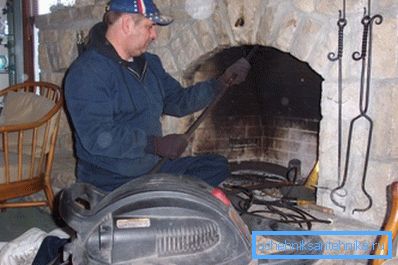How to clean the pipe from soot yourself: available methods
The days when the wood-burning stove was in every house have sunk in the summer. Now stoves are usually found in remote villages or at summer cottages. Currently, fireplaces are more popular in homes, but in any case, all these structures require periodic cleaning.
And it's not even that the stove will burn badly - a clogged chimney can cause the spread of carbon monoxide, which is already life threatening.

How to clean the pipe from soot used to be known in every home; besides, there were whole artels of professional chimney sweeps. In today's times of market relations, such a service also exists, but only the price for it can sometimes frighten.
For this reason, many owners prefer to clean the chimney themselves. In this article we outlined the most popular cleaning methods.
Important: carbon monoxide, unlike smoke, is odorless and colorless. To notice his presence is not immediately possible. Accumulating indoors, it can not only cause serious poisoning, but in some cases can be fatal.

Causes of blockage
The diameter of the outlet pipe has a clear, specified characteristics.
If the construction was mounted by a professional, then all parameters will be strictly maintained.
- Over time, the products of combustion are deposited on the inner surface of the pipes and cause a decrease in volume, which leads to a violation of thrust, as a result, the furnace starts to work worse.
- Another reason for malfunction and excessive accumulation of soot can be errors in the design or laying of the furnace design itself.. The first sign of this will be a worsening of thrust and frequent blockages of the smoke ducts. Cleaning the chimney soot from it will not help here, the stove must be completely shifted.
- Of great importance is the material from which this structure is folded.. Not every brick is suitable for masonry, plus the mortar with which the installation is carried out must be special. A simple cement-sand mixture is not suitable here, it will crack on the temperature.
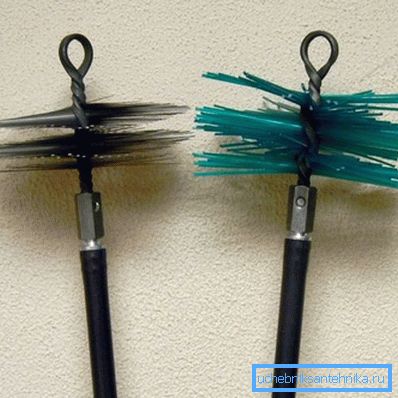
- Not the last role played by the material that is burned in the furnace. Not everything that burns can be used for these purposes. Of course, dry firewood is almost ideal, but the wood is different, it differs in the number of pitches and the temperature of combustion. In addition, special requirements are imposed on coal furnaces, since the temperature of combustion of coal, and especially coke, is several times higher than the temperature of combustion of wood material.
- Finally, the cause of a malfunction in the design may be a banal flue clog of a foreign object.. Often, stoves at dachas are not regularly heated and bird nests can appear in the pipe or wind can cause foliage. To some extent, a protective umbrella over the pipe saves it.
Tip: it is advisable to make the smoke ducts as smooth as possible, each roughness or influx of solution will become a platform on which soot will settle first.

Chimney cleaning options
The question of how to clean the pipe from soot with their own hands can be divided into two directions. The first direction relates more to prevention, if you regularly perform non-complex actions, you can constantly maintain the system in working condition without resorting to radical measures (see also the article The wire for heating pipes is the best means of freezing).
If time was missed, then direct cleaning of the system with the help of special means, as a rule, mechanically, is already required. In particularly advanced cases, it makes sense to turn to specialists.
Available, homemade methods
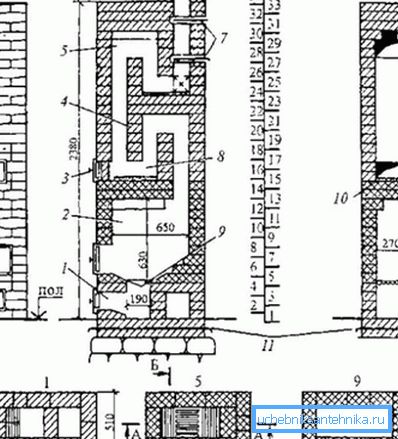
The main preventive method to combat clogging chimneys is the use of ordinary table salt. During intensive burning of fuel in the furnace, some salt should be poured on top of the firewood.
It will begin to evaporate intensively and, reacting with oxygen, will corrode the layers in the pipe. In addition, part of the product will settle on the walls of the chimney and will further prevent the formation of new layers.
No less effective, proven over the years, is the use of potato peel or thinly chopped potatoes. The instructions here are simple, before cleaning the pipe from soot in this way, the cleaning should be pre-dried.
Potatoes contain large amounts of starch, which contributes to the destruction of the plaque structure. In addition, the starch itself is quite a dense and heavy substance, it will not stick to the sheer wall and as a result of the temperature difference, together with the layers it will crumble at the base of the chimney.
After that, you just need to clean out this garbage through a special window.
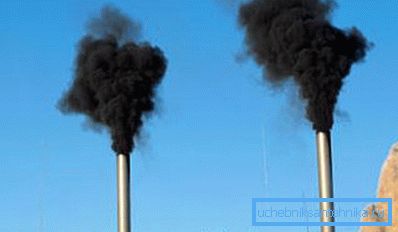
Following years of experience, it can be argued that for such a procedure, as a rule, half a bucket of potato peel is enough. This is an average amount, for bulk constructions you will need more material.
Speaking about how to clean the soot in the pipe can not forget about another available option. The layers on the inner surface of the chimney can fly around by themselves under the influence of high temperatures.
Birch and aspen, when burned, release more energy, so such firewood can cause natural blockage removal. It is better to remove the bark from the logs before that.
Important: the highest temperature during combustion is given by coking coal or directly coke. But not every furnace can withstand such a test. Such type of fuel as coke is used in metallurgy for melting metal.
For such fuel, the stove and the chimney should be made of fireclay refractory bricks, otherwise the walls will crack and may collapse.
The use of modern chemistry
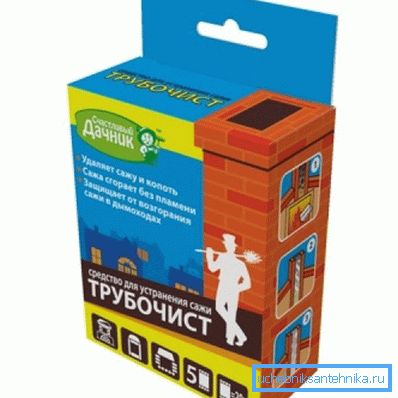
Modern industry in abundance produces various special tools to combat clogging chimneys, but before you clean the chimney from soot in such a radical way, you should make sure that the chemical is harmless.
The leading place here is occupied by a mixture of copper sulphate, saltpeter and coal dust from coking coal. This composition is poured on damped coals, which still maintain a high temperature.
Soot reacting with the fumes, peeling off the walls. But here it is important to know the measure, the amount of such powder should not be more than 200g.
A remedy like PCC acts on the same principle as copper sulfate. In the trading network it comes pre-packaged and ready for use.
You do not need to unpack it, the bag rushes into the firebox and burns. The reaction will not be lightning, but note that one sachet is enough.
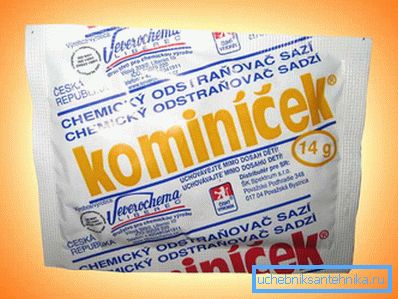
Foreign manufacturers are also not lagging behind. The Czech tool “Kominchek”, according to the developers, is able to remove stratifications up to 2 mm thick. Such a bag weighs within 14g and should not be used more often than 1 time in 3 months.
The so-called log chimney sweep has proven itself well. This is natural wood, with a high burning temperature, impregnated with a special compound that contributes to the destruction of soot plaque.
It is important: of course, cleaning the pipe from soot by chemical means is done quite quickly and efficiently, but the price of such preparations, as a rule, is quite high. Plus, it is advisable to buy only from reputable manufacturers, since chemistry can be dangerous.
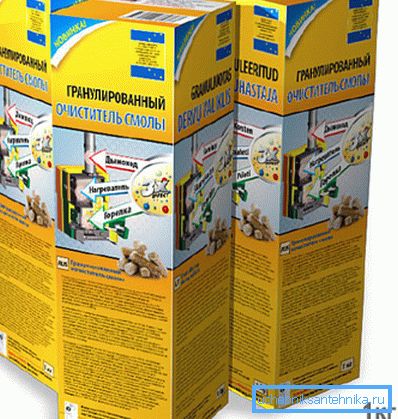
Mechanical method
Often, old structures that have not been exploited for a long time should preferably be cleaned in a proven old-fashioned way with the help of brushes, brushes and scrapers.
- The first thing to start with is to close all the doors in the firebox, and it is also desirable to curtain them with a wet cloth.
- You will definitely need a special metal brush suspended on a long chain or a sturdy metal cable. A steel core of regular round shape is taken as weighting. All elements are connected with carbines.
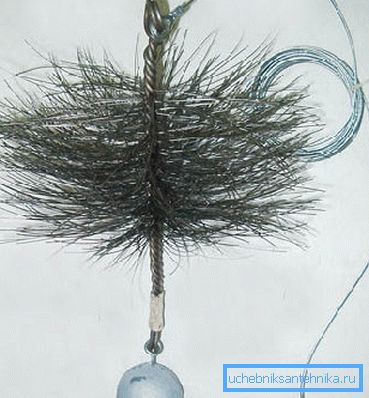
Important: you do not need to use heavy objects like heavy weights for weighting. The core has a balanced center of gravity and is not able to get stuck in the chimney. Non-standard items can skew and weighting sticking in the pipe.
- High-altitude work on the roof is associated with a certain danger, so you should take care of insurance in advance.
- Work begins from the roof, gradually moving to the furnace. Layers with a thickness of more than 2 mm are best removed first with a long scraper and only then proceed to the brush.
- If extraneous garbage, such as fallen from laying brick or bird nests, cannot be removed, it must be punched down with the help of a steel core and scooped through a technological window or furnace. The diameter of the core is taken in the region of 2/3 of the pipe section.
- When work on the removal of soot from the channels is completed, all the garbage is removed through technological holes or the firebox. This should be done carefully, so that soot is not scattered around the room. It is convenient to clean the remains with a damp cloth. Theoretically, the use of a vacuum cleaner is allowed, but it is likely that it will become clogged and broken.
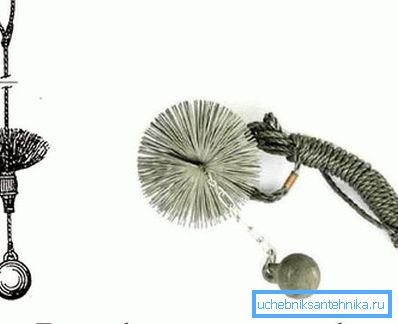
The video in this article shows the details of the chimney cleaning.
Conclusion
Cleaning the pipe soot mechanically with their own hands, deservedly considered the most effective, but it must be done carefully. Experts say that the most suitable time for such works is early autumn and always in calm weather (see also the article The Transparent Pipe: materials and characteristics).
